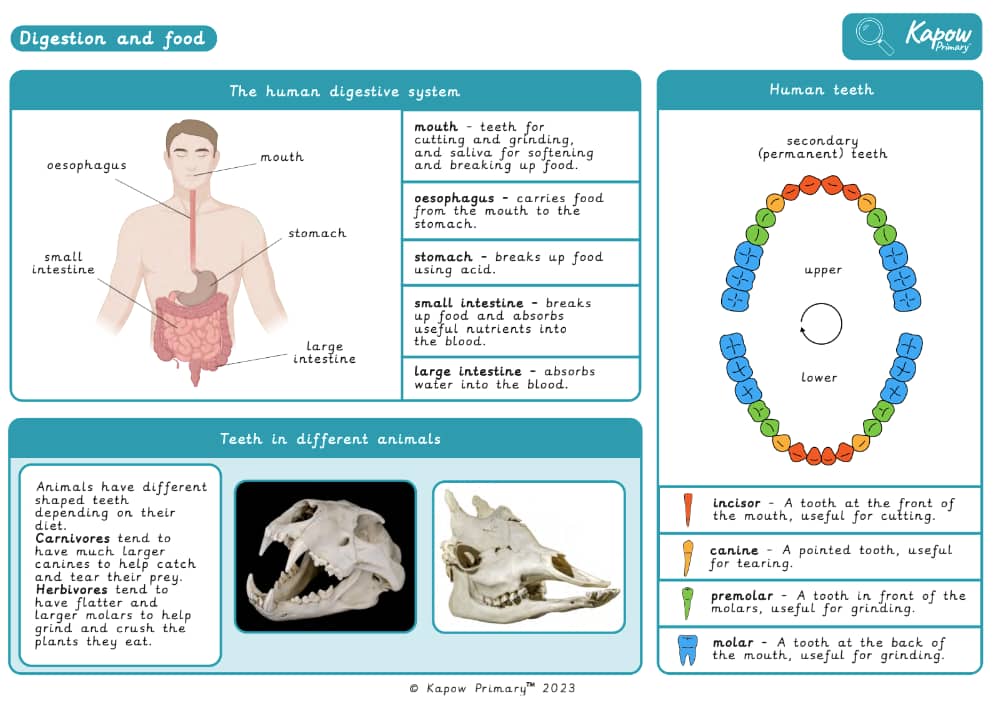Y3/4 (A): Animals, including humans: Digestion and food
Exploring the role of the digestive system and comparing teeth and diets of different animals as part of a food chain.
The Curriculum and Assessment Review final report has been released. We’re reviewing the recommendations and planning for future updates. Learn more
Unit outcomes
Pupils who are secure will be able to:
- Label key organs found in the digestive system and describe each of their functions.
- Describe the functions of the four different types of adult human teeth using key vocabulary.
- Know that good dental care involves brushing their teeth twice a day with toothpaste and a soft toothbrush.
- Produce a food chain that begins with a plant and has arrows that move up the food chain.
- Define a producer, predator and prey and identify examples in food chains.
- Describe digestion, teeth and diets when talking about the observed poo clues.
- Write a letter that uses a range of scientific vocabulary from the unit.
When working scientifically, pupils who are secure will be able to:
- Evaluate a strength or weakness of the digestive system model.
- Describe an example of evidence that can be used to study teeth.
- Evaluate a method by considering its limitations.
- Recall that scientific research needs repeated results before being used in society.
- Identify trends in predators and prey.
- Draw a results table that has space for observations about different poo samples.
Please note that Kapow Primary Science lessons are designed to be 1 hour and 30 minutes long to reflect the requirements of a core subject.
Suggested prior learning
Y3/4 (A): Animals, including humans: Movement and nutrition
Get startedLessons
Y3/4 (A): Lesson 1: The human digestive system
Knowledge
- To describe the function of the human digestive system.
Working scientifically
- To evaluate a model.
Y3/4 (A): Lesson 2: Human teeth
Knowledge
- To recognise the different types of human teeth and their roles in eating.
Science in action
- To describe real observation methods and evidence collected.
Y3/4 (A): Lesson 3: Investigating dental hygiene
Knowledge
- To explain how to care for our teeth.
Working scientifically
- To evaluate a method by considering its limitations.
Y3/4 (A): Lesson 4: Teeth of carnivores, herbivores and omnivores
Knowledge
- To recognise that differences in teeth relate to an animal’s diet.
Working scientifically
- To group animals based on their diet.
Y3/4 (A): Lesson 5: Producers, predators and prey in food chains
Knowledge
- To recognise producers, predators and prey in food chains.
Working scientifically
- To analyse patterns and form conclusions using scientific knowledge.
Y3/4 (A): Lesson 6: Poo clues
Knowledge
- To recognise that animal poo can give us clues about digestion, teeth and diet.
Working scientifically
- To construct a results table for recording observations.
Key skills
Key knowledge
Related content
Unit resources

Knowledge organiser – Science Y3/4 (A): Animals, including humans: Digestion and food
Aimed at pupils, two pages providing key facts and definitions from the mixed-age unit ‘Digestion and food’.

Vocabulary display – Science Y3/4 (A): Animals, including humans: Digestion and food
A display version of the vocabulary from the mixed-age unit ‘Digestion and food'.
Cross-curricular opportunities
English: Spoken language; Writing – composition.
Mathematics: Number – addition and subtraction; Number – number and place value; Measurement; Statistics.
British values: The rule of law; Mutual respect; Tolerance of those with different faiths and beliefs.
Geography: Place knowledge; Human and physical geography.
RSE: Health and prevention.

